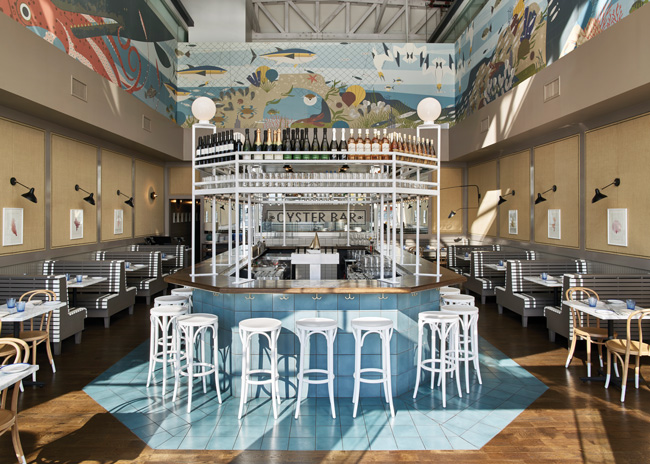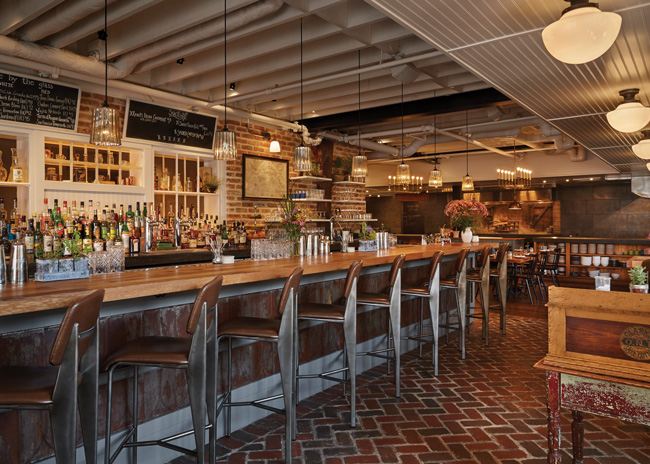 Brian Miller Senior Design Director, Edit Lab at StreetsenseEven more so than dining rooms, restaurant bars need to check multiple boxes for design success. They need to create energy and buzz, promote social engagement, and integrate with and support the overall brand experience while offering an attractive alternative experience. They must balance comfort and style with exceptional durability and operational efficiency with theatrics. Brian Miller, senior design director, Edit Lab at Streetsense, has been designing bars, nightclubs and restaurants in the Washington, D.C., market since 2008. He shares his insights on trends and outfitting choices that raise the bar on bar design.
Brian Miller Senior Design Director, Edit Lab at StreetsenseEven more so than dining rooms, restaurant bars need to check multiple boxes for design success. They need to create energy and buzz, promote social engagement, and integrate with and support the overall brand experience while offering an attractive alternative experience. They must balance comfort and style with exceptional durability and operational efficiency with theatrics. Brian Miller, senior design director, Edit Lab at Streetsense, has been designing bars, nightclubs and restaurants in the Washington, D.C., market since 2008. He shares his insights on trends and outfitting choices that raise the bar on bar design.
Cross-Functionality. “Restaurateurs now see the bar as a crucial, integral component of their offering. Old-school waiting areas near the host stand have pretty much disappeared, and the bar now serves that function,” Miller notes. “But it’s also so much more than that. It’s also a space where new patrons can check out an operation without making a big commitment or stop by for drink on their way to someplace else. And it’s increasingly a place where patrons enjoy eating as well as simply drinking and socializing.”
In the interest of maximizing return on real estate investment, many bar spaces also now do double duty as coffee and pastry stops in the morning and/or cafes at lunch. As such, Miller says, bar materials selection matters more. “You can’t just turn the lights down low and hope the scuffs and marks disappear,” he explains. “Everything needs to look as good when a patron walks in for breakfast or lunch as it does at night.”
Solutions: Materials and finishes that either patina very well or are highly durable and cleanable; sophisticated, flexible lighting that provides the desired level of warmth and intimacy from open to close; rigorous maintenance programs
Energy and Integration. Open kitchens have long been a strategy of choice for adding energy to the dining environment, but bars are increasingly playing that role, too. They’re more up-front, more centralized and more integrated into the overall dining-room experience than ever before, according to Miller.
“The challenge sometimes becomes how to design bars that add life and energy to the dining room but still be protective of people who are looking for a little quieter experience,” Miller notes. “Owners tend to focus on operational implications, but customer experience in both the bar and dining areas is sacred. Things like having a dishwasher behind the bar become bigger decisions when bars are open and integrated. It might look OK and be operationally efficient, but having a big cloud of steam released every few minutes is horrible from a guest perspective. And, depending on the concept, things like blender noise can be very off-putting to dining customers. The sensory experience of what’s happening at the bar becomes just as critical and crucial to consider as the visual experience.”
Miller adds that he prefers to avoid lounge-type seating in bar areas. “We are big fans of having everything bar-height, with a few lower tables for accessibility,” he says. “Once you go into lounge seating, you immediately start to bleed the energy that you generate from density in the bar.”
Solutions: Equipment and materials selections that support and enhance rather than detract from the dining room experience; open sight lines; finishes that match those used in dining areas to create aesthetic continuity; areas designated through use of different materials or bar heights for service staff.
 At Whaley’s in Washington, D.C., the central bar adds life and energy to the dining room. A natural wood bar top adds warmth, while thoughtful touches like purse/bag hooks accessible to every seat help to elevate the guest experience. Images courtesy of Greg Powers
At Whaley’s in Washington, D.C., the central bar adds life and energy to the dining room. A natural wood bar top adds warmth, while thoughtful touches like purse/bag hooks accessible to every seat help to elevate the guest experience. Images courtesy of Greg Powers
Dining at the Bar. With solo diners and even couples increasingly comfortable eating at the bar, the way designers think about dimensions there is changing, Miller says. Storage for meal service supplies and access points for servers are bigger issues as well.
“You need a conversation with the chef early on about things like plate size, how many glasses might typically be set, what things like bread service looks like, etc. It all impacts the amount of space you’ll need to allow and the number and type of seats that you can comfortably get at the bar if people are eating there,” Miller says. “And if the operator or chef wants to drive more diners to the bar, it’s great if the bar has a view of the kitchen or at least is not just looking at a back wall. We recently designed The Dabney in D.C., and every seat at the bar can see the wood-burning hearth that’s at the back of the dining area. These types of things give subconscious cues to go ahead and have a meal there. It feels like more than just a place to have a drink.”
Solutions: Integrated or adjacent service ware storage; furnishings sized to support bar dining; smooth bar tops with generous overhang; lighting designed to enhance appearance of food; sight lines to kitchen or prep areas; adjacent (yet out of sight) bus areas; refrigeration space for easy access to condiments, butters, etc.
 Keeping open sight lines to food prep gives subtle cues that encourage dining at the bar. At The Dabney in Washington, D.C., bar patrons have a great view of the wood-burning oven at the back of the dining room.
Keeping open sight lines to food prep gives subtle cues that encourage dining at the bar. At The Dabney in Washington, D.C., bar patrons have a great view of the wood-burning oven at the back of the dining room.
Mixology. Drink menus are increasingly broad and specialized, making storage and equipment choices more complex. “These are really major issues today,” Miller says. “Previously, bartenders just inherited whatever was designed for them and made it work. Everyone used a few types of standard glassware. If a restaurant or bar switched head bartenders during the course of build-out, it wouldn’t make any difference to the equipment. Now, bartenders play a much bigger role in driving the space, the menu, the equipment setup, etc. Bar programs have such a specific point of view that even a staff change can trigger different equipment and fit outs. It can make it more difficult up front, but in almost all situations, the bartender knows what people are looking for at the bar in ways that the restaurant group or operator may not, so it’s really valuable input. The worst thing is to see a bar that’s been badly set up for the program they’re trying to create.”
Solutions: Bring the bartender/bar manager into the design conversation early; let program and menu drive design decisions; focus on ergonomics and cockpit-style workstations that put key ingredients, tools and glassware for high-volume drinks within easy reach
Comfort. The level of comfort desired in a restaurant bar setting is a topic for discussion early in the design process and one that is highly concept dependent. And it has to do with more than simply seating choices. Materiality, lighting and acoustics all dramatically affect guest comfort and amenities such as purse/bag hooks. Device ports and outlets are part of the mix as well.
For bar tops, Miller opts for softer, more porous materials over synthetics. “They can be higher maintenance, but they feel really spectacular, warm and comfortable,” he says. “We’ve even done a couple of bars with wood edges and embossed leather on the bar top. We thought we might have to replace the leather every couple of years, but our oldest one just turned 10 and still has the original leather top.”
He cautions against making bar areas a little too comfortable, however. “A lot of operators are very concerned about comfort in bar seating, but then when their restaurants open, they worry that people are staying too long because it’s too comfortable,” Miller says. “It’s a balancing act. Comfort does need to be addressed, but a bar seat that’s relatively ergonomic, maybe with a divot instead of a cushioned back, can work wonders. A stool with a back also might be very comfortable for the person sitting in it, but if it’s a busy bar, that type of seating makes it tough for those standing behind it to access the bar and have a good experience.”
Solutions: Under-bar purse/bag hooks easily accessible from every seat; subtle incorporation of device ports/outlets — not too hidden, not too obvious; ergonomic versus plush seating; natural bar-top materials, such as wood, stone and leather; flooring and barstools chosen for acoustic properties as well as visual and physical properties (or foot pads for metal-leg stools on concrete floors)
